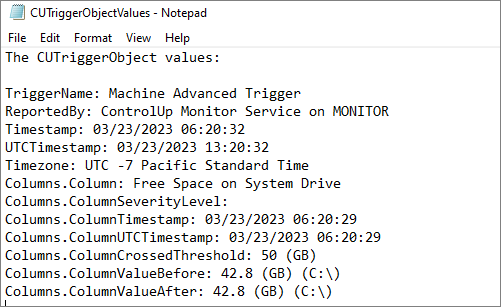An advanced feature of triggers is the capability to pass trigger-related parameters to follow-up actions. For example, you can pass crossed threshold values, trigger names, or stress levels to emails or scripts. From version 9.0.5, you can configure trigger actions with PowerShell cmdlets.
How To Use
To pass trigger-related information to a script action, you need to use the $CUTriggerObject variable. See below an overview of available properties, the trigger types for which you can use each property, and the parameter name you need to use for each use case.
Not all properties are supported by every trigger type. To determine which properties are available for a specific trigger, refer to the Trigger Type column.
| Property | Description | Trigger Type | Parameter Name |
|---|---|---|---|
| TriggerName | The name of the trigger, as specified by the user in the Trigger Settings screen | All | $CUTriggerObject.TriggerName |
| ReportedBy | The entity that reported the incident | All | $CUTriggerObject.ReportedBy |
| Timestamp | The time at which the incident occurred (in the triggering Monitor's timezone) | All | $CUTriggerObject.Timestamp |
| UTCTimestamp | The time at which the incident occurred (UTC) | All | $CUTriggerObject.UTCTimestamp |
| Timezone | The triggering Monitor's timezone | All | $CUTriggerObject.Timezone |
| Column | The name of the column | Advanced, Scheduled, Stress Level | $CUTriggerObject.Columns[index].Column |
| ColumnSeverityLevel | Severity Level | Advanced, Scheduled, Stress Level | $CUTriggerObject.Columns[index].ColumnSeverityLevel |
| ColumnTimestamp | For Advanced triggers, the time at which the column was changed; for Stress triggers, the time at which the stress on the column began. The time given is for the triggering Monitor's timezone. | Advanced, Scheduled, Stress Level | $CUTriggerObject.Columns[index].ColumnTimestamp |
| ColumnUTCTimestamp | For Advanced triggers, the time at which the column was changed; for Stress triggers, the time at which the stress on the column began. The time given is UTC. | Advanced, Scheduled, Stress Level | $CUTriggerObject.Columns[index].ColumnUTCTimestamp |
| ColumnCrossedThreshold | For Advanced triggers, the threshold that was set for the column; for Stress triggers, the stress threshold that was set for the trigger | Advanced, Scheduled, Stress Level | $CUTriggerObject.Columns[index].ColumnCrossedThreshold |
| ColumnValueBefore | For Advanced triggers, the column's value before it was changed | Advanced, Scheduled | $CUTriggerObject.Columns[index].ColumnValueBefore |
| ColumnValueAfter | For Advanced triggers, the column's value after it was changed | Advanced, Scheduled | $CUTriggerObject.Columns[index].ColumnValueAfter |
| EventSource | Source field of the event | Advanced, Scheduled | $CUTriggerObject.Event.EventSource |
| EventType | Level field of the event in the EventLog | Windows Event | $CUTriggerObject.Event.EventType |
| EventID | Event ID | Windows Event | $CUTriggerObject.Event.EventID |
| EventFullMsg | Event content | Windows Event | $CUTriggerObject.Event.EventFullMsg |
| ValueBefore | Session state before it changed | Advanced, Scheduled | $CUTriggerObject.Session.ValueBefore |
| ValueAfter | Session state before it changed | Advanced, Scheduled | $CUTriggerObject.Session.ValueAfter |
Simple Use Case
The following use case creates a trigger that fires when the free space on disk is lower than 50 GB. This triggers an Automated Action (trigger that runs a script as a follow-up action) that passes information about the trigger to the script.
- Create a script with the following content shown below. What this script does is to write a
CUTriggerObjectValue.txtin C:\tmp.
$OutputFile = "C:\tmp\CUTriggerObjectValues.txt"
Clear-Content $OutputFile
Add-Content -Path $OutputFile -Value "The CUTriggerObject values:`n"
Add-Content -Path $OutputFile -Value "TriggerName: $($CUTriggerObject.TriggerName)"
Add-Content -Path $OutputFile -Value "ReportedBy: $($CUTriggerObject.ReportedBy)"
Add-Content -Path $OutputFile -Value "Timestamp: $($CUTriggerObject.Timestamp)"
Add-Content -Path $OutputFile -Value "UTCTimestamp: $($CUTriggerObject.UTCTimestamp)"
Add-Content -Path $OutputFile -Value "Timezone: $($CUTriggerObject.Timezone)"
if ($null -ne $CUTriggerObject.Columns) {
for ($i = 0; $i -lt $CUTriggerObject.Columns.Count; $i++) {
Add-Content -Path $OutputFile -Value "Columns.Column: $($CUTriggerObject.Columns[$i].Column)"
Add-Content -Path $OutputFile -Value "Columns.ColumnSeverityLevel: $($CUTriggerObject.Columns[$i].ColumnSeverityLevel)"
Add-Content -Path $OutputFile -Value "Columns.ColumnTimestamp: $($CUTriggerObject.Columns[$i].ColumnTimestamp)"
Add-Content -Path $OutputFile -Value "Columns.ColumnUTCTimestamp: $($CUTriggerObject.Columns[$i].ColumnUTCTimestamp)"
Add-Content -Path $OutputFile -Value "Columns.ColumnCrossedThreshold: $($CUTriggerObject.Columns[$i].ColumnCrossedThreshold)"
Add-Content -Path $OutputFile -Value "Columns.ColumnValueBefore: $($CUTriggerObject.Columns[$i].ColumnValueBefore)"
Add-Content -Path $OutputFile -Value "Columns.ColumnValueAfter: $($CUTriggerObject.Columns[$i].ColumnValueAfter)"
}
} else {
Add-Content -Path $OutputFile -Value "No columns were passed.`n"
}

-
Create an Advanced Trigger and create a To this state: condition and add the condition as shown in the screenshot below

-
In our case, the disk space on the system drive of the machine "MONITOR" falls below the trigger condition of "50 GB and below. This immediately triggers the script to run.

-
Upon examining the text file, we can confirm that the trigger successfully populated the values in it:

Refer to this example for how the object $CUTriggerObject can be used in triggers.